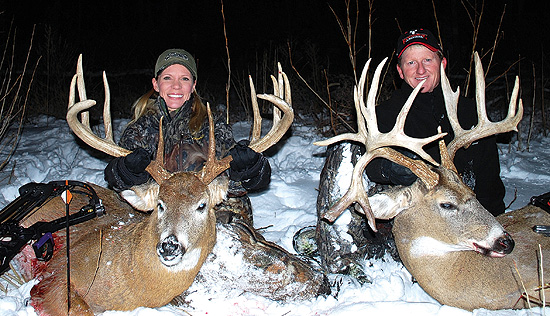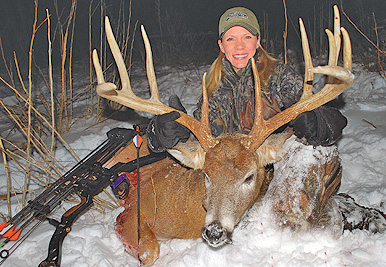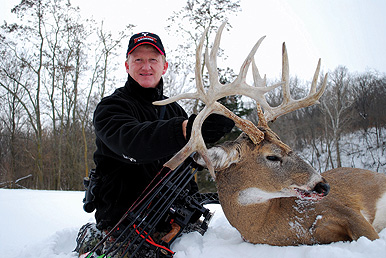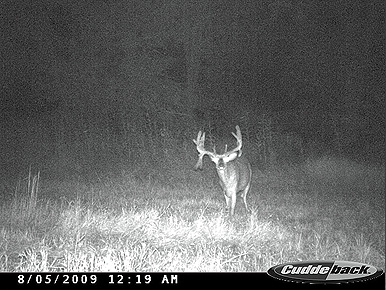Without a doubt, taking a giant buck from the ground is one of the toughest feats in bowhunting. That said, it certainly can be done. Read on to learn more about some amazing bucks taken from the ground and get some ideas on how you can go eye-to-eye with your own monster buck.

With four days of season left, Jay and Tammi Gregory took these incredible Kansas bucks from their ground blind. Tammi arrowed hers first – an 11-point, 181-inch typical. Twenty minutes later, Jay took a 16-point non-typical with a huge drop-tine that scored 193 inches.
Jay and Tammi Gregory are hunting industry veterans whose television program, The Wild Outdoors, has entertained countless big-buck enthusiasts for nearly 20 years. Though the Gregorys hunt multiple states each season, most of their hunts take place in the Midwest, where giant whitetails lurk.
Several years ago, Jay and Tammi starting hunting from ground blinds. They found some of the areas they hunted had no suitable trees for stands, so they opted to try something different. They enjoyed success with their “ground level” approach, and many of their television shows and DVDs have chronicled their amazing hunts.
A few seasons back, Jay was hunting a big buck he nicknamed “Cookie Monster.” The giant buck had double drop-tines and all the ingredients of an old monarch — huge body, massive, gnarly antlers and long tines. Jay decided he would hold out for the Kansas Cookie Monster and pass up all other bucks.
Jay, Tammi and their son Wyatt had previously hunted the Diamond Springs Ranch in northeast Kansas and enjoyed success. The ranch is home to some big-racked bucks with heavy bodies thanks to the ample agricultural crops in the area. After setting up several game cameras and a Trophy Rock during the summer, the Gregorys got several photos of a big, double drop-tine buck, along with some other nice bucks.
Before archery season opened, Jay and Tammi set up a Primos Double Bull blind in a cornfield the big buck frequented. As time permitted, they hunted their Kansas “honey hole” for nearly 90 days and were afforded only distant glances at the brute.

Tammi Gregory shows off her 11-point Kansas monster — a deer that was harvested just 20 minutes before her husband Jay took a 16-point non-typical. The duo combined to take down 374 combined inches of antler in half an hour!
On Dec. 27, after 10 inches of snow blanketed the area, the Gregorys decided to give the Kansas spot another try, knowing the season would be closing soon. After arriving at their blind that afternoon, the big, drop-tined buck appeared in a woodlot 200 yards away. Cautiously, the rut-worn monarch approached the cornfield, but unfortunately for Jay, circled out of range. Jay’s heart sank as the big buck fed and vanished without offering a bow shot.
The next day, Jay decided to move the blind closer to the area where the buck entered the field. After repositioning the blind, Jay and Tammi settled in for the afternoon hunt as temperatures plummeted to near zero.
At 4:15 p.m., several does and small bucks began to filter across the snow-packed cornfield to the last remaining standing corn. In moments, a wide 11-point buck appeared and headed towards the blind. Jay quickly took over the filming chores, allowing Tammi to grab her bow as the biggest buck of her life approached. At 20 yards, the buck stopped broadside and Tammi made a great shot, sending her Rage-tipped arrow perfectly behind the buck’s shoulder.
The mortally hit buck wheeled and ran, but collapsed only 60 yards away in plain view. Emotion washed over Tammi as she soaked in the previous minutes. She was ecstatic having just killed her highest scoring buck ever!
Twenty minutes later, Jay spotted movement on the distant ridge and saw another buck approaching — it was Cookie Monster! Amazingly, the drop-tined buck walked directly into the cornfield, stopping to lip curl to check if any of the does present were in estrus, before feeding.
With Tammi behind the camera, Jay ranged the brute at 38 yards. When the buck turned broadside, Jay sent a well-placed arrow that struck the majestic buck high in the lungs. The buck ran out of the field and headed up the ridge, staggering and falling just out of sight.
After a brief wait, the Gregorys retrieved their trophies and took photos just before darkness fell. In 30 minutes, the couple had taken two monster bucks. Tammi’s giant, wide-racked 11-pointer scored 181 inches. Jay’s long-awaited buck — Cookie Monster — had broken off some points from earlier photos, including a drop tine, but still carried 16 points and scored an amazing 193 inches!

Outdoor television host Jay Gregory took this gnarly 193-inch, 16-point non-typical buck during a late-season ground blind hunt in Kansas. Gregory’s brute previously had double drop-tines but broke one off during the rut.
Few archers are more qualified to offer advice on big bucks than Jay Gregory. The seasoned bowhunter has taken 14 bucks over 170 inches, including five that score 180 or higher. Jay uses several tactics that lend to his success, and he believes they can work for you as well.
Although the vast majority of bowhunters hunt from treestands, Gregory says the effectiveness of ground blinds should not be overlooked. “Ground blinds offer some unique advantages,” Gregory said. “When no trees are available in a well-used area, a ground blind can be set up and will usually work well.”
Some hunters are not inclined to hunt from treestands due to their ages or physical limitations. When I introduced my wife Donna to hunting, I knew she had a fear of heights. Coaxing her up a 20-foot ladder into a treestand was out of the question. My dilemma was remedied by employing a pop-up blind. In our blind, we can stay reasonably warm, be sheltered from rain and wind and, best of all, our movements are largely hidden within the camouflage confines of our ground blind. Donna considers hunting from a ground blind fun and has taken a variety of game at extremely close range.
When deciding on a spot for a ground blind, consider a few things: Which direction do I expect the deer to approach from? Can the blind be set up with the wind in my face? Scouting will show some spots are better locations for a blind than others. Gregory scouts his areas with a game camera and by long range observation so he won’t contaminate the area with human scent.
“Certain areas such as fencerows and cornfields are prime locations for pop-up blinds,” Gregory said. “Ground blinds like the Double Bull work well in almost any hunting situation, provided you keep a few things in mind.
“Deer have definite travel routes or well-worn trials they generally use when undisturbed. These areas will be well defined with tracks. These are great spots for ground blinds. Whitetails prefer to cross fences in particular places, and the exact location of these spots can be found by observation, or by using one of the new scouting cameras with plot watcher capabilities.”
These high-tech cameras can monitor a food plot for 12 hours, and then stitch together a time-lapsed video of the entire day’s action that can be viewed in 10 minutes.

Jay Gregory says trail cameras are excellent tools for selecting ground blind locations. They will reveal trophy animals and help pinpoint their travel patterns.
Gregory said hunters should take time to blend their ground blinds into the natural surroundings so it doesn’t scare deer.
“If deer can make out the outline of the blind’s roof, it will spook them sometimes,” he said. “When available, I like to back my blind up into cedar trees; it breaks up the outline well. When brushing in a blind, use native vegetation so it will look more natural.”
Although Gregory has set up a ground blind and hunted from it immediately, the deer pro generally sets up his hide a few days in advance to let the deer get accustomed to it.
Gregory recommends wearing black or dark camouflage clothing when hunting from a ground blind.
“You also must make sure your hands and face are covered,” he stressed. “Also make sure there is nothing shiny on your bow.”
Occasionally, Gregory employs a deer decoy to help entice a rut-crazed buck, but cautions that dekes can spook does. He never calls from a blind unless he’s using a decoy. He believes calling without a decoy causes bucks to be more cautious, since blinds are usually set up in more open areas. Jay says that bucks will usually approach a decoy head on after circling it. He places his decoy 20-25 yards away in front of his blind, slightly quartering toward the blind. He says when bucks approach the “imposter” they will offer a broadside or quartering away shot, usually inside of 20 yards. Gregory suggested using gloves when handling a decoy and says he sprays his decoy down with a product he has found to be heads above all others— Head to Hoof. Made by Stonybrook Outfitters, Gregory says “the spray contains a doe’s entire body smell — complete with all the glandular secretions. I spray Head to Hoof on my decoy and it works well. It smells like a live deer.”
Lastly, scent control is paramount when hunting from the ground. Though treestand hunters can get away with scent at times — thanks to thermal wind currents that lift their scent upwards — ground blind hunters should take extra precautions. Jay uses an Ozonics machine in his blind that neutralizes human scent with ozone. Admitting the machines are costly, Gregory says hunters spend tons of money each season on scent-free clothing and sprays each that have little or no effect.
“For roughly the same money you can buy an Ozonics machine,” he said. “I used the machines before they were one of my sponsors and can attest to their effectiveness.”
by Mike Lambeth




























